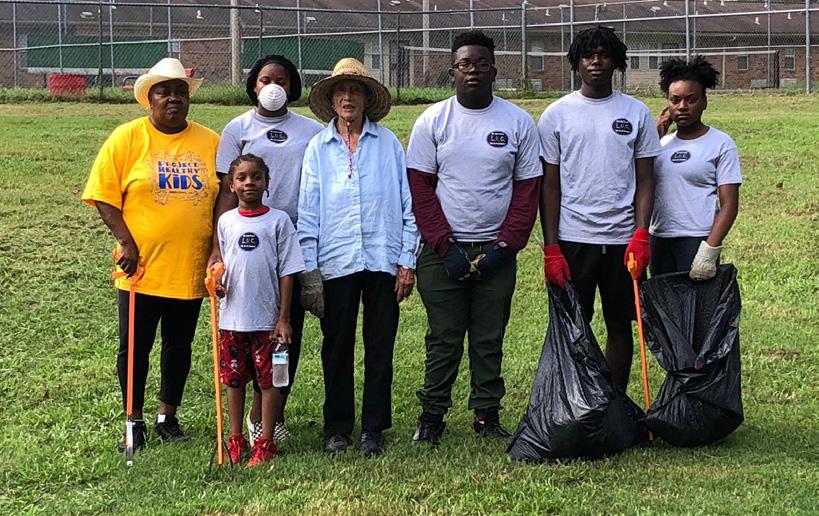
5 minute read
Evaluating
SNJM writings
“While the quality of life on the planet is deteriorating, women and children suffer the most. ...we look at Earth through the eyes of women and commit to change our attitudes and behaviors as consumers, to sensitize and educate to the reality of eco-feminism, to take a stand especially against violence toward women, children and the earth, and to be in solidarity with groups that work for human rights and the life of the planet.” (1996)
- Kay Burton, SNJM
The rose Project Post-Reflection Evaluating
From Scripture:
He said, “This is how it is with the kingdom of God; it is as if a man were to scatter seed on the land and would sleep and rise night and day and the seed would sprout and grow, he knows not how. Of its own accord the land yields fruit, first the blade, then the ear, then the full grain in the ear. And when the grain is ripe, he wields the sickle at once, for the harvest has come.” - Mark 4:26-29
Reflection:
I came to Jonestown because from 1978-1980, I taught in Clarksdale, Mississippi at Immaculate Conception High School. I had an 11th grade homeroom and taught a variety of subjects and was an academic counselor. Two of my homeroom students, both young women, came in from Jonestown every day and unlike the rest of the students, were very undereducated. During the course of those two years, I visited their families in Jonestown and learned how the discriminatory practices were so devastating. At that time and until 1984 there was no mandatory education for children in Mississippi. (In 1984, the six-year-olds were required to attend first grade—that is how it started). I thought, back in 1979 that if we SNJMs, who are trained teachers, could help educate, we should. So we began. As Provincial Director of the [former] SNJM Washington Province, with the members of our Council, in August, 1984, we sent four Sisters to live and work in Jonestown (Sisters Rose Monica, Mildred Hein, Anne Skok and Teresa Shields). In 1989 SNJMs started the Durocher Volunteer Service Program geared to encourage service on the part of the youth, focusing on education, especially during the Durocher Summer School sessions. The Sisters also contributed to founding Jonestown Family Center (JFC) in 1992, with a mission to improve educational and health opportunities through its programs. As other people brought their gifts over the years, its preschool learning center has now evolved into a Montessori school led by women who are education professionals. I continue [to minister in Jonestown] because my faith, my heart and whatever else there is says so. A little effort does a lot of good and makes a huge difference. I focus on volunteer
service because we all need to help one another without counting the cost to ourselves (I believe); and now, after over 30 years, I am reaping the rewards of having those whom I helped long ago, help others. Having volunteers come to Jonestown from other places is beneficial, in my mind, to everyone! Included in the Durocher Program is offering hospitality to student and adult volunteers who, with local persons, are able to meet some housing and educational needs. A sense of community can be developed as learning experiences abound.
e- Sister Kay Burton, Jonestown, Mississippi
1. What seeds were planted in you during this week? 2. What seeds did you plant through your
Rose Project? 3. In what ways do you hope these seeds might grow for the sake of
God’s kingdom? 4. Just as the work of the
Sisters is a sign of the land that yields fruit, we too are called to be laborers in the vineyard of God growing seed:
How might you “cast fire” further here in
Tampa Bay? In Florida?
In our country? Our
World?
Prayer Request
Pray for all the missionaries, that they may find gratitude in their learning experiences.
Closing Prayer
(below) Sister Marylyn’s community in Winnipeg: top left to right: Sisters Geraldine MacNamara, Marylyn Gibney, Carol Peloquin; bottom left to right: Lesley Sacouman and Johanna Jonker. (below right) Sister Gerry with the first ‘Rossbrookers’.


Pictured (above):
Sister Marylyn
Gibney.
Sister Kay (left) and Sister Mary Ellen (right) visit the chapel of the Lovers of the Holy Cross.
Pictured (right):
Sister Mary Ellen
Robinson. Sister Rosemary (left) and Sister
Cynthia Canning
(right) with ChaShonn (center), one of their students from Next Step, who since has graduated from San Francisco State University.
(above right) Teen volunteers serve lunch to children in “Mexico en Wapato” a summer program of language and cultural immersion led by teachers from Mexico.






The first locations for Heritage College were a cottage and sycamore tree (far left), the site of the very first classes in fall 1981, followed by an old 1926 elementary school building (left), used until 1993. (below) Sister Kathleen and Heritage College students celebrate the opening of a new campus facility.



(above) Sister Kay Burton and Girls to Women members plant in their community garden. (right) Sister Kay and another teacher from Immaculate High School in Seattle participate in a march for open housing in the 1960s. (above right) In honor of Mother Marie Rose, a group complete a service project with Sister Kay.


